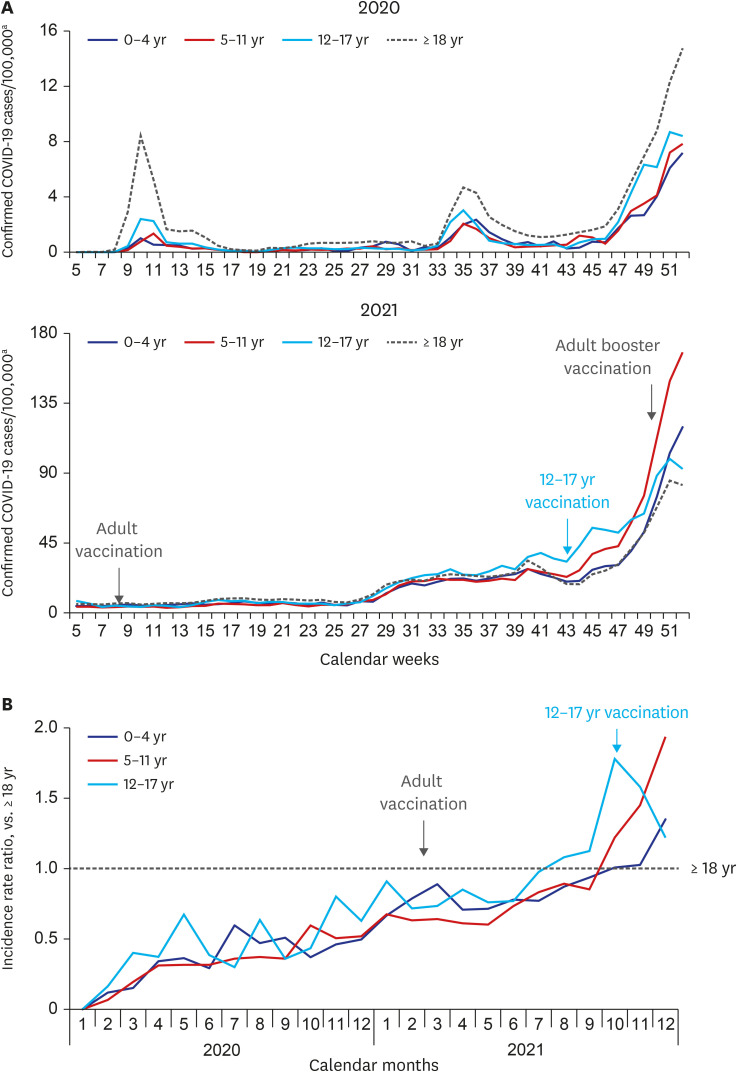1. Boehmer TK, DeVies J, Caruso E, van Santen KL, Tang S, Black CL, et al. Changing age distribution of the COVID-19 pandemic - United States, May–August 2020. MMWR Morb Mortal Wkly Rep. 2020; 69(39):1404–1409. PMID:
33001872.
2. Lopez Bernal J, Andrews N, Gower C, Robertson C, Stowe J, Tessier E, et al. Effectiveness of the Pfizer-BioNTech and Oxford-AstraZeneca vaccines on COVID-19 related symptoms, hospital admissions, and mortality in older adults in England: test negative case-control study. BMJ. 2021; 373:n1088. PMID:
33985964.
3. Moline HL, Whitaker M, Deng L, Rhodes JC, Milucky J, Pham H, et al. Effectiveness of COVID-19 vaccines in preventing hospitalization among adults aged ≥65 Years - COVID-NET, 13 States, February–April 2021. MMWR Morb Mortal Wkly Rep. 2021; 70(32):1088–1093. PMID:
34383730.
4. Choi MJ, Choi WS, Seong H, Choi JY, Kim JH, Kim YJ, et al. Developing a framework for pandemic COVID-19 vaccine allocation: a modified Delphi consensus study in Korea. J Korean Med Sci. 2021; 36(23):e166. PMID:
34128597.
5. Choe YJ, Yi S, Hwang I, Kim J, Park YJ, Cho E, et al. Safety and effectiveness of BNT162b2 mRNA COVID-19 vaccine in adolescents. Vaccine. 2022; 40(5):691–694. PMID:
35012777.
6. Woodworth KR, Moulia D, Collins JP, Hadler SC, Jones JM, Reddy SC, et al. The advisory committee on immunization practices’ interim recommendation for use of Pfizer-BioNTech COVID-19 vaccine in children aged 5–11 years - United States, November 2021. MMWR Morb Mortal Wkly Rep. 2021; 70(45):1579–1583. PMID:
34758012.
8. Siegel DA, Reses HE, Cool AJ, Shapiro CN, Hsu J, Boehmer TK, et al. Trends in COVID-19 cases, emergency department visits, and hospital admissions among children and adolescents aged 0–17 years - United States, August 2020-August 2021. MMWR Morb Mortal Wkly Rep. 2021; 70(36):1249–1254. PMID:
34499628.
9. Elliott P, Haw D, Wang H, Eales O, Walters CE, Ainslie KEC, et al. Exponential growth, high prevalence of SARS-CoV-2, and vaccine effectiveness associated with the Delta variant. Science. 2021; 374(6574):eabl9551. PMID:
34726481.
10. Choe YJ, Park YJ, Kim EY, Jo M, Cho EY, Lee H, et al. SARS-CoV-2 transmission in schools in Korea: nationwide cohort study. Arch Dis Child. 2022; 107(3):e20. PMID:
34857510.
11. Chang TH, Wu JL, Chang LY. Clinical characteristics and diagnostic challenges of pediatric COVID-19: a systematic review and meta-analysis. J Formos Med Assoc. 2020; 119(5):982–989. PMID:
32307322.
12. Han MS, Choi EH, Chang SH, Jin BL, Lee EJ, Kim BN, et al. Clinical characteristics and viral RNA detection in children with coronavirus disease 2019 in the Republic of Korea. JAMA Pediatr. 2021; 175(1):73–80. PMID:
32857112.
13. Korea Disease Control and Prevention Agency. COVID-19 dashboard. Updated 2022. Accessed January 25, 2022.
http://ncov.mohw.go.kr/
.
15. Lee PI, Hu YL, Chen PY, Huang YC, Hsueh PR. Are children less susceptible to COVID-19? J Microbiol Immunol Infect. 2020; 53(3):371–372. PMID:
32147409.
16. Lee H, Choi S, Park JY, Jo DS, Choi UY, Lee H, et al. Analysis of critical COVID-19 cases among children in Korea. J Korean Med Sci. 2022; 37(1):e13. PMID:
34981683.
17. Lam-Hine T, McCurdy SA, Santora L, Duncan L, Corbett-Detig R, Kapusinszky B, et al. Outbreak associated with SARS-CoV-2 B.1.617.2 (Delta) variant in an elementary school - Marin County, California, May–June 2021. MMWR Morb Mortal Wkly Rep. 2021; 70(35):1214–1219. PMID:
34473683.





 PDF
PDF Citation
Citation Print
Print




 XML Download
XML Download